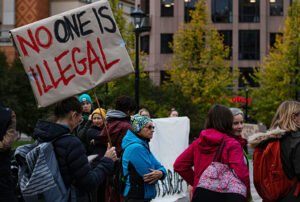
“PEOPLE’S TIME” BY FABIO MESA/WWW.FABIOMESA.COM
This article will appear in the Fall 2012 edition of The Nonprofit Quarterly.
Northeast Ohio Neighborhood Health Services (NEON) delivers an array of health services—from preventive to specialized care and dental—to more than forty thousand Cleveland area residents. NEON’s six centers are part of the nation’s network of federally funded community health centers that serve the primary healthcare needs of more than twenty million uninsured and limitedmeans patients in over eight thousand locations across the United States. This year, for the first time, one of their services is helping patients to register and vote.
NEON sees active civic participation in all its forms—voting, advocacy, community engagement, and more—as another way to improve health outcomes among the people (and the neighborhoods) it serves. When patients come in for a visit or attend one of NEON’s community events, the organization uses the opportunity to offer them the chance to register to vote or update their registration. Those with current registrations are being asked to fill out a “pledge to vote” card, and receive follow-up information to help them vote on November 6.
This April, Colorado’s Peak Vista Community Health Centers launched a similar campaign, aimed at their sixty-two thousand clinic visitors. The entire enrollment staff received in-depth training on voter registration and the positive measures of health associated with civic engagement. Like NEON, Peak Vista care providers are encouraging everyone coming in for services to register and pledge to vote this fall.
NEON and Peak Vista represent a growing number of service-oriented nonprofits using their civic reach to encourage voter participation. In 2012, both are tracking their activities as part of new research to evaluate the impact of nonprofit service providers who incorporate voter outreach into their services. Can nonprofits play a larger role in closing participation gaps and increasing voting among traditionally underrepresented communities?
Challenges and Opportunities
The participation gaps among communities served by nonprofits were never more evident than in the 2010 election. The census reported that lower-income voters (earning less than $50,000) trailed higher-income voters by twenty points. Young people under thirty voted at half the rate of older voters, with similarly low voting rates among Latino and recent immigrant populations.1
These participation gaps challenge the mission of nonprofits and diminish the voice of both the organizations and the communities they serve and engage. Elected officials are less likely to visit, campaign in, or respond to low-voting communities. Nonprofits that remain on the sidelines of formal politics and whose constituents don’t vote have less access after the election to officeholders and government leaders.
For the individuals whose lives nonprofits strive to improve, nonparticipation means missing out on the benefits of engagement in the political process. People who register and vote are more likely to talk to their neighbors, meet with local officials, and engage in other civic actions.2 Studies show that states with higher voting levels have, among other attributes, higher levels of selfreported health,3 lower ex-offender recidivism rates,4 and even lower unemployment.5
Nonprofits of the 501(c)(3) variety are presumed to have a limited capacity for promoting political participation because laws prohibit them from engaging in partisan politics to support or oppose a candidate for public office. Yet nonprofits’ inherent civic engagement assets make them a potent force for political and electoral engagement, further strengthened by their nonpartisan approach. For instance:
- Nonprofits are among the nation’s most trusted messengers. An annual Harris poll consistently ranks nonprofits among the few sectors (small businesses are another) that respondents would like to have more rather than less influence in government;6
- The civic reach of the nonprofit sector is unparalleled, with its several-hundred-thousand active community-based nonprofits with over ten million employees and sixty-one million volunteers serving more than one-hundred and fifty million Americans annually; and (above all)
- Nonprofits have the kind of daily in-person contact with the potential voting public unavailable to partisan campaigns.
Outside of a small number of advocacy organizations, nonprofits have been underachievers in their civic mission vis-à-vis the realm of political participation. In elections, nonprofits misinterpret the prohibition against partisan political activity to mean no activity at all. Voter participation efforts have become more professionalized. Those advocacy nonprofits that engage in elections have increasingly adopted a campaign model with expensive field operations and highly targeted door-to-door and phone programs, neither one of which is a good fit for the rest of the sector. Even if interested in increasing their civic engagement, the majority of community-based nonprofits, service providers, and the like have lacked the guidance and models to do so.
A New Approach
In 2012, a rapidly increasing number of nonprofit service providers like NEON and Peak Vista are adopting a newer model of voter engagement based on their built-in engagement assets and connection to underrepresented populations. Instead of the campaign approach that uses voter lists to contact voters at home, theirs is an agency- or community-based approach, taking place with people whom nonprofits interact with every day. It’s like a reverse door-knocking—an engaging of people coming through their doors. The agencybased voter-engagement approach is:
- Integrated and less expensive. It is integrated into preexisting services and activities without adding a new program.
- More personal and trusted. It uses the personal contacts nonprofits already have at points of service, classes, trainings, meetings, and neighborhood activities. It occurs at a place people trust and with people they know.
- Varied and scalable. There’s no one agencybased engagement model. Every nonprofit takes its own approach based on its services, interests, and capacity.
- Mission-, issue-, and community-based. Voter engagement taking place on-site at a nonprofit ties elections more directly to the social mission of the organization, the issues it cares about, and the community it serves.
- Year-round. Nonprofits are community institutions with deep roots in their service areas and that interact with their constituents all year long. For service providers promoting voter participation, it’s part of a year-round civic engagement commitment that continues after Election Day.
Nonprofit Voter Engagement on the Rise
The spread of agency-based voter engagement is propelled by the growth in state and national nonprofit networks encouraging their affiliates to incorporate nonpartisan election engagement activities into their programming, as well as the rise in local nonprofits taking this approach. A dramatic increase in activity at Nonprofit VOTE is both a bellwether and a window into this trend.
Nonprofit VOTE partners with America’s nonprofits to help the people it serves participate and vote. It provides nonpartisan resources, training, and tools to help nonprofits integrate voter engagement into their ongoing activities and services. In the last six months, Nonprofit VOTE has tripled its partnerships with such national nonprofit networks as Lutheran Services in America, Feeding America, the Boys & Girls Clubs of America, and Goodwill Industries. State nonprofit associations in more than half the states have signed on to promote the work and the model to their members.7 More networks have created branded voter-engagement initiatives as part of their public policy programs, which ten years ago only existed in Minnesota and Massachusetts, among a few other places.8
The Arc, a national network for people with developmental disabilities, launched a We’ve Got the Power: Vote in 2012 campaign to mobilize its seven hundred chapters. The YWCA set up a dedicated website with election resources for its affiliates under the banner “Your Voice—Your Vote—Your Future” to better incorporate voter outreach into their activities. The National Association of Community Health Centers (NACHC) has expanded its signature Community Health Vote program among its fifty-state network of 1,100 health centers. At the midpoint of 2012, more than three hundred health centers had signed on—nearly twice the number in 2008. NACHC has made civic engagement a year-round priority, and Community Health Vote is just one part of NACHC’s ongoing efforts to connect civic participation and health, promote self-advocacy skills for its patients, and raise the visibility of community health centers as valued assets to their communities.
Sign up for our free newsletters
Subscribe to NPQ's newsletters to have our top stories delivered directly to your inbox.
By signing up, you agree to our privacy policy and terms of use, and to receive messages from NPQ and our partners.
Nine states—Arizona, California, Colorado, Louisiana, Massachusetts, Michigan, Minnesota, North Carolina, and Ohio—have new or morebroadly- based voter-engagement initiatives as part of the public-policy programs at state or regional nonprofit associations. The Protecting Arizona’s Family Coalition—a statewide network of health and human service organizations—and the Alliance of Arizona Nonprofits are providing regular voter engagement training for the state’s nonprofits. Local Colorado foundations have supported the newly formed Colorado Participation Project to assist nonprofits in adopting and implementing the agency-based approach to voter and civic engagement. The California Association of Nonprofits—CalNonprofits—has taken a different approach. It rolled out a Vote with Your Mission campaign aimed at having 100 percent of eligible nonprofit staff, board members, and volunteers vote. The campaign was done in recognition that staff and volunteers are far more likely to encourage voter participation among their service population if they themselves are registered and voting. Vote with Your Mission promotes a values-based approach to voting that ties participation with the nonprofit’s issues and mission.
In tandem, and as a consequence of increased voter engagement by state and national partners, Nonprofit VOTE is tracking a sharp increase in the more than seven thousand local nonprofits accessing its resources, ordering tool kits, and getting trained in how to incorporate nonpartisan election participation activities into their programs and services. The growth is spread across all fifty states and visible in every type of nonprofit: community action programs; family and children services; disability agencies; neighborhood centers; immigrant-serving organizations; health clinics; food banks; job training and literacy programs; and more.
New Research
Recent voter-mobilization research underscores the potential added value of nonprofits using their civic reach to encourage voter participation. The most well-known is the work of Donald Green and Alan Gerber, authors of Get Out the Vote: How to Increase Voter Turnout.9 Their 2008 book distills a decade of over one hundred research experiments examining political mobilization by partisan and nonpartisan organizations by phone, mail, door-to-door canvassing, and paid media. The factor that proved by far the strongest across all the experiments was personal contact from a peer or someone a person knows. A landmark study by the James Irvine Foundation, which evaluated voter mobilization by nine prominent community-based organizations in California between 2006 and 2009, reached the same conclusion. The three-year study, called New Experiments in Minority Voter Mobilization, reiterated that the factor most likely to drive voter participation was personal contact by people “from the same local neighborhood” or “personally known to targeted voters.”10
Through daily personal contact with and trust among the people they serve, nonprofits are woven into the fabric of their communities, making the nonprofit sector, more than any other, a natural fit for any kind of voter or civic mobilization. In contrast, conventional campaign methods don’t or aren’t able to make personal contact with more than half of the nation’s voters, according to the American National Election Studies, which has tracked political engagement in presidential elections for more than fifty years.11 Even when contact is made, it is often by paid canvassers or volunteers not known to the voter.
Through 2009, almost all voter-mobilization research had focused on traditional field campaigns using voter lists to contact voters at home: at the door, on the phone, or by mail. In 2010, Nonprofit VOTE and the Michigan Nonprofit Association commissioned a study of seven Detroit social service agencies conducting voter engagement. Participants included a community action agency, a Head Start center, a family services program, and local Catholic charities. The providers tracked voter contact with six hundred clients who were divided into treatment groups that were either approached or not approached by the agency about voter registration and voting.12 The results showed that voters contacted by the agencies were 17 percent more likely to vote than those not contacted. While even one contact made a difference, the likelihood of voter turnout increased with additional contacts. Furthermore, those contacted by their nonprofit were also more likely to talk to their families and friends about the election, a multiplier effect noted before in other research, such as David Nickerson’s “Is Voting Contagious? Evidence from Two Field Experiments.”13 Although the data were promising, the sample size of the Detroit study was small and the results preliminary.
In 2012, a much larger cohort of nonprofits have joined new research on the agency-based approach to voter engagement. In fourteen states, 110 service providers are tracking their voter registration and voter engagement activities, with forty to fifty thousand people receiving services at their locations. Supported by the Ford Foundation and Open Society Foundations, the work, which is part experimental and part research evaluation, is coordinated by state partners of Nonprofit VOTE and the Colorado-based Service Providers and Civic Engagement project (SPaCE).
Each participating nonprofit is contacting people it serves in the context of its regular programs about registering to vote and updating their registration, or, if already registered, urging them to sign a card pledging to vote on November 6. Everyone who is contacted receives at least one follow-up by mail, text message, or phone with information about voting in his or her state. After the election, there will be a check of state voter files to see how many of the expected forty to fifty thousand people contacted by their service provider voted. Did contacted voters turn out at higher or lower rates than the average in their county or state? Can we find differences in the mobilization impact by different types of nonprofits or kinds of follow-up? Beyond the data, the efforts of each individual nonprofit will yield a robust set of case studies on the capacity of service providers to integrate voter engagement into their services and strategies.
Lessons Learned
From the research and three cycles of promoting the agency-based voter engagement model, Nonprofit VOTE and its partners have learned a number of lessons about what factors are conducive to nonprofit voter engagement and what does or doesn’t work:
- Buy-in. Voter engagement at nonprofits takes place when it is a priority for at least one program or frontline staff member who is a point person for the activities. Buy-in from senior staff is also a critical factor. This is reflected in post-election surveys of organizations conducting voter engagement and illustrated by the fact that every group joining our research efforts did so with support from the executive director.
- Network support. Nonprofits are more likely to promote voter engagement when encouraged to do so by national and state nonprofit networks to which they are connected. Health centers have done more to register and educate voters because of repeated messaging from both the national association (NACHC) and state associations of health centers of which they are members. The same has been true in the disability community, where a number of national organizations—the Arc, American Association of People with Disabilities, National Multiple Sclerosis Society, and others—have made access to the voting process a policy priority with a branded program.
- Mission-driven engagement. Nonprofits are more likely to incorporate voter participation around elections if civic engagement or advocacy is part of their mission statement.
- A more-than-just-voter-registration approach. In the past, voter engagement has been defined mainly as voter registration. This has been problematic for nonprofits that have more limited capacity to conduct voter registration on an ongoing basis. Registration drives can be challenging without trained staffing and good systems for returning forms. Many nonprofits have had better results focusing on other kinds of election activities such as hosting candidate forums, working on ballot measures, or helping and reminding their constituents to vote.
- Keeping it simple. Most nonprofits have found that the best strategy for voter engagement is to choose a few targeted activities into which they can incorporate voting—for example, signing up people for a new service or engaging clients during literacy or training classes (or wherever there’s a captive audience and time to ask about registering to vote and voting).
- Staying close to the election but planning ahead. The other major finding of the Green-Gerber and Irvine Foundation research was that voter mobilization efforts have their greatest impact closer to the registration deadline or election. All social service agencies in the Detroit study conducted their voter engagement in the final two months before the November election. The organizations with the best results had planned their activities and identified staffing ahead of time.
- Using events. Events of a civic nature or those directly sponsored by a nonprofit are good for voter outreach. The Massachusetts Immigrant and Refugee Advocacy (MIRA) Coalition registered over a thousand voters in a single day at a new citizen naturalization ceremony. A Los Angeles health center partnered with a local high school to register students at graduation. Nonprofit-sponsored events like walks or open houses have proved to be successful single-day engagement opportunities, too.
- Benefit-driven approach. Above all, nonprofits are most likely to undertake voter engagement when they have an understanding of the potential benefits to advancing the issues they care about, services they provide, and greater personal efficacy for their constituents and community.
Conclusion
The trend toward greater political engagement by the nonprofit sector is likely to continue, whether driven by the growing necessity of having a voice in longer-term debates over fiscal policy and the role of government or because of the documented personal and social benefits of civic participation for organizations and the people they serve.
Several factors are in place that could make this trend more sustainable. Nonprofits are incorporating voter engagement not as a separate activity but as part of a year-round, mission-driven strategy of civic participation that includes other forms of advocacy and community engagement. There is growing institutional support for nonpartisan voter engagement from sector leaders such as the Independent Sector, National Council of Nonprofits, and a wide range of state and national nonprofit networks. Far more resources exist today than even just a few years ago from nonprofits like Nonprofit VOTE, the Alliance for Justice, and others.
Nonprofits cannot endorse candidates—but they can endorse voting. When they do, it has an impact, as illustrated by the social service agencies in the Detroit study. The broad data on the reach of the sector, its role as a trusted messenger, and recent mobilization research point to the potential of nonprofits as engines of civic participation14— in particular, their personal connection to underrepresented populations not reached by partisan political campaigns.
In 2012, nonprofits are seizing upon this potential in two ways. The first is the sheer expansion of nonprofits taking steps to “endorse voting”— promoting voter registration, organizing voter education, getting out the vote, connecting with candidates, taking stands on ballot measures, and the like. The second is a first-of-its-kind largescale evaluation of the voter-engagement efforts of over one hundred nonprofit service providers of all types and geographies. Through case studies, the research will provide a road map that documents specific agency-based strategies adopted by different types of nonprofits to promote voter participation and will illustrate what has and hasn’t worked. It holds the potential both to inform the efforts of nonprofits already encouraging voting and to motivate and guide a far greater number of nonprofit service providers to incorporate voter engagement in future years.
With a better road map, guidance, and resources, nonprofits and civic organizations can make a large and lasting contribution to growing the electorate and closing participation gaps. They can leverage engagement assets to elevate the voice of the nonprofit sector and communities they serve at the table of democracy—adding new strength and vitality to their historic role as a positive force for social progress and civic renewal.
George Pillsbury, MPA, is founder and executive director of Nonprofit VOTE. Prior to that, George founded and directed MassVOTE, a nonpartisan voter engagement organization in Massachusetts. His work in the fields of philanthropy, social investing, and voter and civic participation spans three decades.
Notes
- Nonprofit VOTE, America Goes to the Polls 2010: Voter Participation Gaps in the 2010 Midterm Election, 2011, www.nonprofitvote.org/voter-turnout.html.
- The Center for Information & Research on Civic Learning and Engagement, CIRCLE Blog, “Civic Engagement among Registered Voters and Non- Registered Eligible Citizens,” October 17, 2011, www .civicyouth.org/civic-engagement-among-registered -voters-and-non-registered-eligible-citizens/.
- Tony A. Blakely, Bruce P. Kennedy, and Ichiro Kawachi, “Socioeconomic Inequality in VotingParticipation and Self-Rated Health,” American Journal of Public Health 91, no. 1 (January 2001): 99–104, www.ncbi.nlm.nih.gov/pmc/articles /PMC1446487 /pdf /11189832.pdf.
- Florida Parole Commission, Status Update: Restoration of Civil Rights (RCR) Cases Granted 2009 and 2010, 2011, fpc.state.fl.us/PDFs/2009 -2010ClemencyReport.pdf.
- National Conference on Citizenship et al., Civic Health and Unemployment: Can Engagement Strengthen the Economy?, September 16, 2011, ncoc .net/unemployment.
- PACs, Big Companies, Lobbyists, and Banks and Financial Institutions Seen by Strong Majorities as Having Too Much Power and Influence in DC, PR report on 2012 edition of Harris’s annual poll, May 29, 2012, www.harrisinteractive.com/vault/Harris%20 Poll%2045%20-%20Power%20and%20Influence_5%20 29%2012.pdf.
- For a list of Nonprofit VOTE state and national partners, see www.nonprofitvote.org/about.html.
- These efforts include MassVOTE, CareVote of the Providers’ Council of Massachusetts, the Minnesota Participation Project, and the American Association of People with Disabilities’ Disability Vote Project.
- Donald P. Green and Alan S. Gerber, Get Out the Vote: How to Increase Voter Turnout, 2nd ed. (Washington, DC: The Brookings Institution, 2008).
- Melissa R. Michelson, Lisa García Bedolla, and Donald P. Green, New Experiments in Minority Voter Mobilization: Third and Final Report on the California Votes Initiative (San Francisco: The James Irvine Foundation, 2009), irvine.org/images/stories /pdf/grantmaking/cavotesreportfinal.pdf.
- American National Election Studies, The ANES Guide to Public Opinion and Electoral Behavior, “Political Involvement and Participation in Politics,” 2008, electionstudies.org/nesguide/gd-index.htm#6.
- Kelly LeRoux, Nonprofits Strengthening Democracy: Key Findings from an Agency-Based Voter Mobilization Experiment, March 2011, www.non profitvote.org/download-document /mobilization -experiment-report-leroux.html. Expanded version, by LeRoux and Kelly Krawczyk, forthcoming in 2013 in the Nonprofit and Voluntary Sector Quarterly.
- David W. Nickerson, “Is Voting Contagious? Evidence from Two Field Experiments,”American Political Science Review 102, no.1 (February 2008): 49–57, www.nd.edu/~dnickers/files /papers/Nickerson .APSR2008.pdf.
- See also LeRoux, “Nonprofits as Civic Intermediaries: The Role of Community-Based Organizations in Promoting Political Participation,” Urban Affairs Review 42, no. 3 (January 2007): 410–422, uar.sagepub .com/content/42/3/410 .abstract; Erwin De Leon et al., Community-Based Organizations and Immigrant Integration in the Washington, D.C., Metropolitan Area (Washington, DC: The Urban Institute Center on Nonprofits and Philanthropy, 2009), www .urban.org /UploadedPDF/411986 community_based _organizations.pdf.












